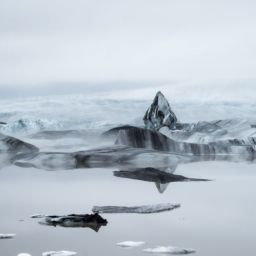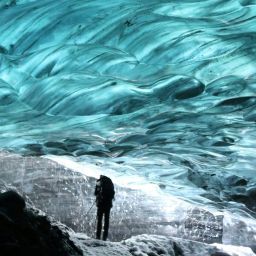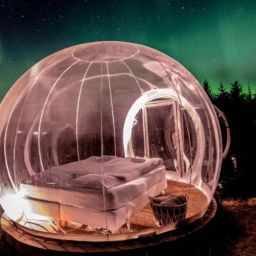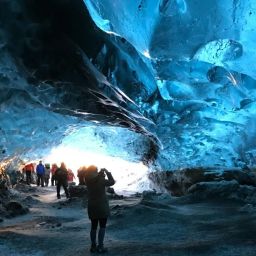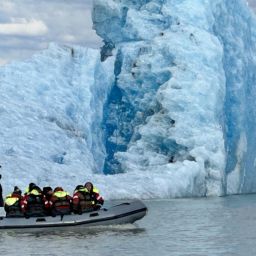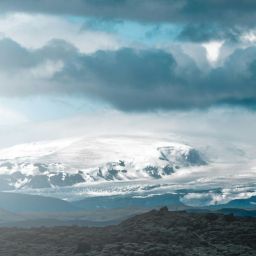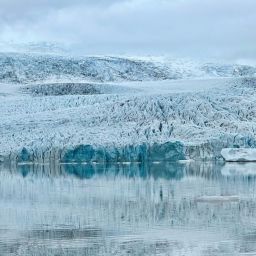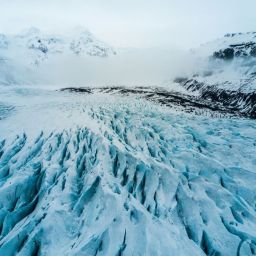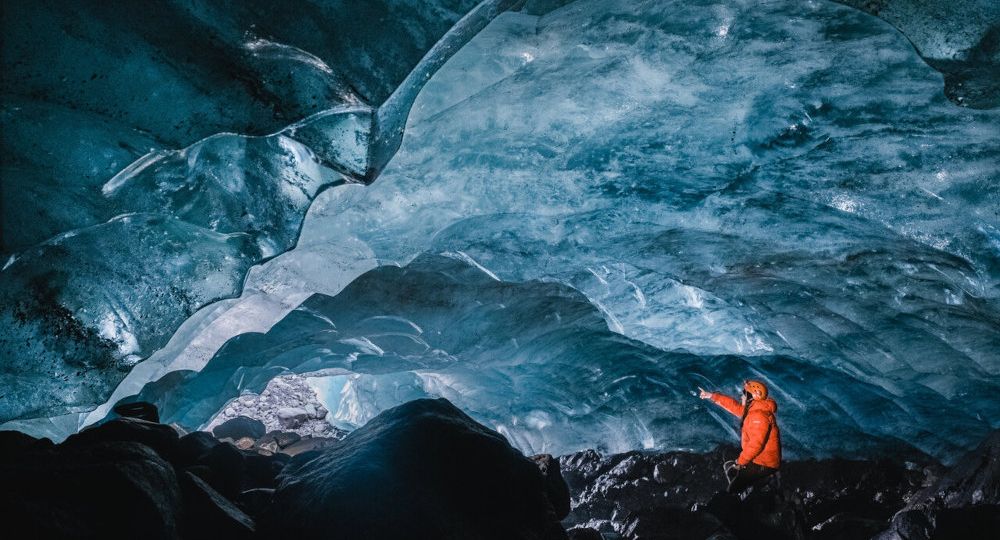
Ice caves in Iceland and beyond are one of the most incredible sights nature can offer us. They are scattered across the planet but Iceland, thanks to its abundance of glaciers, is blessed with many of them.
Visit an ice cave and you’ll understand why you might say they’re awesome or wonderful – this is the kind of place those adjectives were intended to describe. It’s the kind of experience that you’ll remember for the rest of your life and most likely, you will want to go home to tell your friends and family all about it. It pays to be prepared so we have put together information about ice caves that should help you make the right choice for you.
What are ice caves and how are they formed?
“Ice caves” is one of those umbrella terms that we use without paying too much attention to what it means. For an ice cave to exist, it needs to have a temperature of at most 0°C in at least part of the space all year round and water must be able to get in and out. Therefore, ice caves can take several forms.
For example, a rocky cave that sits in a frigid landscape might become iced up. Within it, or perhaps just at its entrance, you might see stalactites and stalagmites that are icicles instead of rock pillars. But either way, geographers would consider you accurate if you called this an ice cave.
Lava tubes and limestone caves can also become an ice cave in the right conditions. Iceland’s Lofthellir, formed in a volcanic eruption about 3500 years ago, is one such place. Located close to Lake Mývatn in the northeast of the country, it’s often littered with ice sculptures and you can access it during the summer. The largest ice cave in the world, Eisriesenwelt in Austria, is a limestone cave underneath the ice.
Now, you might be reading this and feeling a little puzzled. Weren’t the ice caves Iceland brags about on the internet a vivid shade of blue? Bear with us if we are being pedantic for a minute: those are glacier ice caves – which means they’re still an ice cave, but more specifically, a particular type of ice cave.
Glacier ice caves are jaw-droppingly beautiful and so it’s hardly surprising that they generate such a buzz on social and mainstream media. It’s hard to look at a picture and not want to see one for yourself when it has this much of a wow factor. If you’re keen to visit one, then let’s begin with a very brief lesson in glacier formation.

Vatnajokull Glacier- Photo by Sharad kandoi
Let’s start with a bit of background about glaciers in general
Glaciers form when snow falls in large quantities on high ground and accumulates. The weight of this snow makes it compact. As it does so, the air is squeezed out and the snow is transformed into ice. It’s the same process as when you crush snow under your boot as you walk over a wintry pavement, but on a much grander scale.
Over time, the ice thickens. More snow falls, and more compactions happens. Over many years, this tongue of ice becomes pretty weighty, and it moves slowly downhill because of gravity. Though it will try to grab onto rocks and scree by freezing around them, gravity is more powerful and those loose boulders will end up within, under or beside the glacier – we call that moraine.
The friction between the ice and the valley floor beneath it provides natural lubrication as it starts to melt the bottom of the glacier. The body of ice also has a plastic quality, and flexes as it goes over the uneven surface. But high up, the ice is relatively brittle and this can cause cracks and crevasses in the ice.
More on those incredible blue ice caves
The most splendid of the ice caves in Iceland are hollowed out within the glacier’s ice. During the warmer months, the sun beats down on the glacier’s surface. This creates higher temperatures causing a partial thaw. But the puddles of water don’t sit on the glacier’s surface. Instead, this meltwater finds its way into those cracks and, again because of gravity, finds a path down through the ice. It also flows into holes on the glacier’s surface called moulins.
As they come into contact with each other, the liquid meltwater is relatively warm in comparison to the solid ice of the glacier. The water slowly but surely erodes the ice to create holes and hollows. Over time, these are widened and enlarged to become ice caves. From the surface of the ice they remain hidden, but can be accessed from the edges of the glacier.
The most impressive glacier ice caves in Iceland are blue in colour. The reason why is that light is formed of a spectrum of colours, each with different wavelengths. When ice is compacted into snow, it becomes much denser. As light passes through the ice, red light is absorbed. But light can travel much further into the ice, and if we look at a space where the red light has not managed to penetrate, what we see is blue.

Blue Ice Cave -Photo by Paxson Woelber
Is it better to visit a natural ice cave?
On Langjökull, Iceland’s second largest glacier, it’s possible to visit a manmade ice cave. A few years ago, a team of engineers achieved something that had previously not been thought possible – they bored a tunnel into the glacier. To ensure it would be accessible all year long, this had to be done high up on the glacier, which added its own challenges as the gradient is steep and the terrain very bumpy.
Tourists are driven up to the tunnel entrance in a huge truck and then walk into the ice cave on foot. It’s a good option if you’re visiting the Reykjavik area for a summer trip or you don’t have the time to travel along the south coast to experience one of Vatnajökull’s ice caves. It’s undoubtedly an impressive feat of engineering and a remarkable place to visit.
However, there’s something quite extraordinary about setting foot where nature has created an ice cave without any intervention whatsoever. That’s why at Fjallsárlón, we look forward to taking our guests to a stunning glacier ice cave throughout the winter months The cave is nicknamed the Sapphire Ice Cave due to the blue apparent colour. – it really is a special experience.
Do you need to visit an Icelandic ice cave with a guide?
In short, yes.
Ice caves are constantly evolving thanks to those natural processes that form and shape them. Companies such as Fjallsárlón that offer ice cave tours to places like Vatnajökull monitor these natural landforms closely as well as keeping a close eye on meteorological conditions not only at the time of your visit but in the weeks and months preceding it. Ice caves, though utterly majestic, are dangerous places. This is especially the case as the temperatures rise as cave-ins are a real possibility.
We can’t stress this enough: for your safety it is therefore essential to go with an experienced guide who has a thorough knowledge of the area’s ice caves.
That’s not the only reason, though. Ice caves in Iceland are also often accessed from high up on a glacier. This means that they are best approached in a super jeep which is a specially modified vehicle. Thanks to its high clearance, it can cope with the uneven terrain found in such an environment and you won’t get stranded.
Tour companies that offer ice cave excursions can invest in these, but as a tourist your rental car won’t be able to tackle such routes. Without question, you’d find it tricky to get up there, let alone find the entrance to a cave which may have moved since you found out about it.
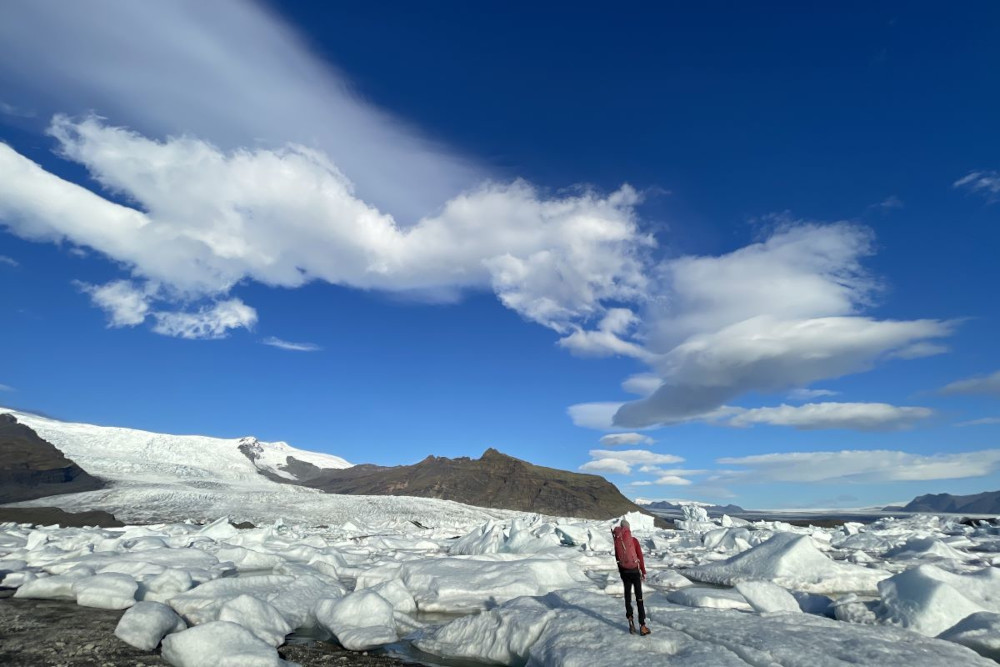
Fjallsarlon Glacier Guide
When’s the best time of year to visit a blue ice cave in Iceland?
Depending on which ice cave you plan to visit, it’s possible to step inside an ice cave in Iceland throughout the year. However, the experience you’ll have differs a lot depending on when you plan to book it. If you have in mind a visit to one of Iceland’s dazzling blue ice caves, then you’ll need to organise your visit for between November and March.
Over this period, the plummeting temperatures found on Iceland’s glaciers usually ensure that the hollowed-out caverns beneath their surface freeze solid. This means the risk of the roof caving in drops dramatically and access becomes a possibility. Towards the end of the season, the temperature starts to rise and then it becomes a different story. The ice caves are again off-limits for safety reasons, and you’ll have to wait until next winter to go.
How to tick an ice cave in Iceland off your bucket list
Vatnajökull is Europe’s largest glacier and as such, this is the best place to come if you hope to visit a blue ice cave. You should definitely put this at the top of your bucket list as to see one with your own eyes is a magical experience. Fjallsárlón offer excursions to blue ice caves, Sapphire ice cave from their base in south Iceland which is easily accessible from the country’s ring road.
If you’re wondering what to expect, then the hike is doable for those of moderate fitness. You won’t be walking on the surface of the glacier, though the trail you follow might be slippery and icy itself. Each day, the guide will set out with a small group towards Breiðamerkurjökull, which is an outlet of Vatnajökull glacier. We time the visit carefully to try to avoid other groups, which you’ll appreciate within the confines of the Sapphire ice cave, especially if you’re taking pictures.
When you reach the ice cave, the group will venture inside to a magnificent cavern of translucent blue ice. The first thing you’ll notice is the colour, but then you’ll become conscious of how the ceiling and walls of the ice cave are dimpled and rippled. These patterns have been caused as meltwater washes over the surface of the ice and then refreezes. The light is almost ethereal, and the sight is sure to have you catching your breath and staring open-mouthed in awe.
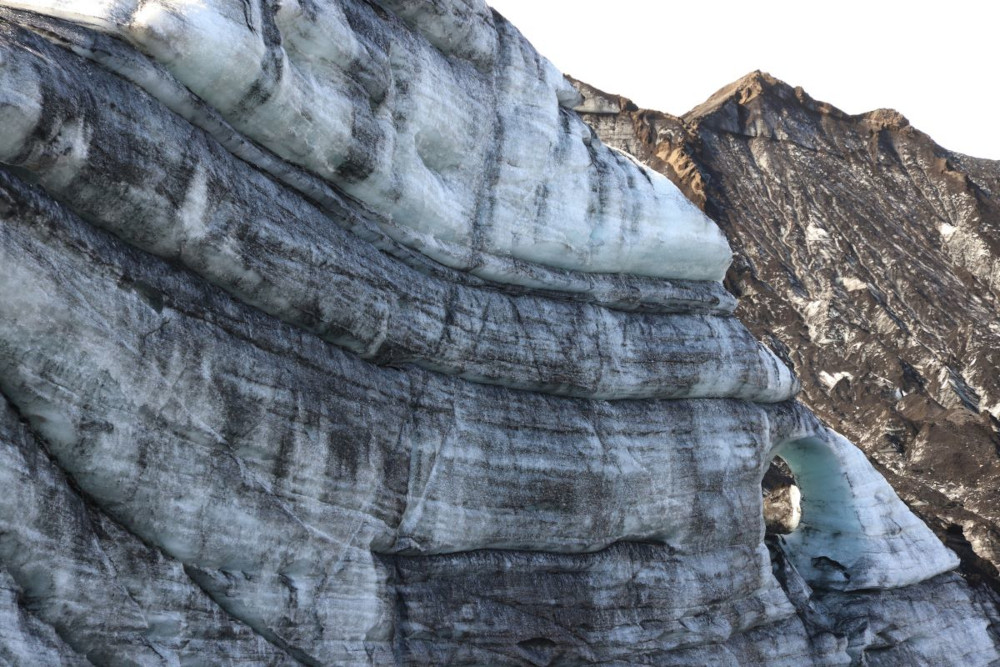
Katla Ice Cave – 66North
Where else do you find ice caves in Iceland?
In spring, summer, and autumn visiting a traditional ice cave in Iceland is not a possibility due to the risk of collapse. But if you’re desperate not to miss out and still keen to see the inside of ice caves in Iceland, there’s a way of making it happen. Ice caves of a slightly different nature can also be found up on Kötlujökull (an outlet glacier of Mýrdalsjökull) in the glaciers that shroud the volcano Katla. Tours are often possible from Vik year-round.
As you might expect from ice that’s got in the way of past eruptions, there’s plenty of evidence of ash within the white ice, so expect to see bold streaks and striations of charcoal grey and black running through it. The ash gives the ice caves a monochromatic quality and very dramatic. If you’re hoping to grab a selfie while you’re there, pop on something in a bold colour to stand out.
How should you prepare for a visit to an ice cave in Iceland?
The most important part of your preparation for visiting any kind of ice cave is your personal safety. Booking with a reputable tour company such as Fjallsárlón is a must. They’ll also take care of the specialist equipment you need, including crampons which you pull on over your own hiking boots to give you a better grip on the ice – and by the way, make sure those boots are sturdy, with a thick sole and ankle support. You’ll be issued with a helmet to protect your head, for instance, in case you take a tumble.
Dressing for the wintry environment is also something to think carefully about. You’ll need to ensure you stay warm in the face of sub-zero temperatures and the biting wind that can blow across the surface of the ice. Thermal base layers are a must. Many seasoned hikers swear by merino wool, though certain synthetic fabrics are also suitable. You need to ensure that these layers wick moisture away because if sweat cools the skin, you’ll feel much colder.
On top of your base layer you add more layers, such as fleeces and/or wool sweaters. The idea is to trap warm air in the spaces between each piece of clothing. Keep the wind and any rain or snow out by ensuring you have a decent jacket over the top. It needs to be waterproof, windproof and thick enough to keep you warm. You can rent hiking boots, waterproof jackets and pants on location if you do not have them yourself.
Over trousers and thermal leggings will help keep your legs from feeling cold too. Lastly, keep your extremities warm with suitable hat, gloves and scarf. Remember – you can always take layers off if you get too warm. If you think that’s likely, take a small day pack too. Pack your camera and perhaps a spare battery or portable charger for top-ups if needed.
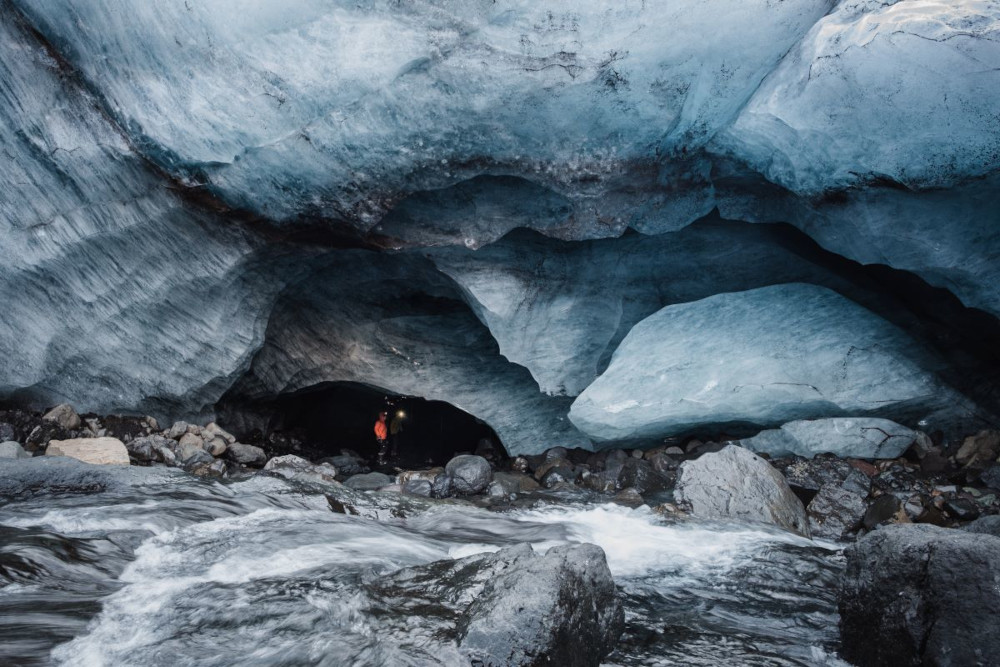
Vatnajokull Fjallsarlon Ice Cave entrance – norbphoto
Want to visit a glacier ice cave?
We hope that after reading this you can’t wait to book an ice cave tour with us during your trip to Iceland. If that’s the case, why not take a look at availability on the Fjallsárlón website or get in touch if you have any queries.





